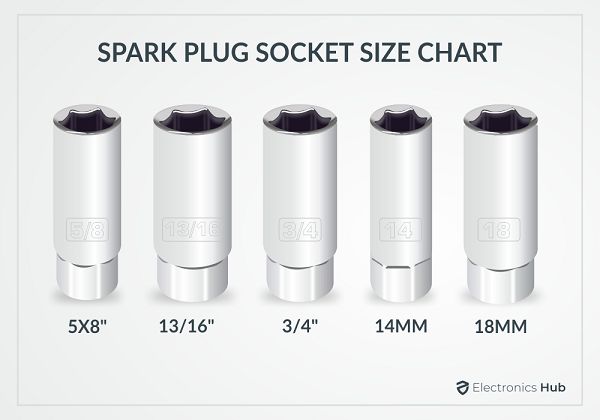When it comes time to replace your vehicle’s spark plugs, having the right socket size is crucial for removing the old plugs smoothly and installing the new ones properly. Most spark plugs are removed using a 5/8″ or 13/16″ socket, but socket sizes can vary depending on the make and model of vehicle.
Page Contents
Spark Plug Socket Sizes by Vehicle
Here is a quick reference for the most common spark plug socket sizes needed for different vehicle makes and models:
| Vehicle Make | Vehicle Model | Socket Size |
|---|---|---|
| Ford | F-150 | 5/8″ |
| Toyota | Camry | 5/8″ |
| Honda | Civic | 5/8″ |
| Chevrolet | Silverado | 5/8″ |
| Nissan | Altima | 5/8″ |
| Dodge | Ram | 5/8″ |
| Jeep | Wrangler | 13/16″ |
| Volkswagen | Jetta | 5/8″ |
| BMW | 3 Series | 5/8″ |
| Mercedes-Benz | C-Class | 5/8″ |
As you can see, 5/8″ is by far the most common spark plug socket size, fitting most American and Asian vehicles. However, some European luxury vehicles and trucks or SUVs with higher performance engines may require the larger 13/16″ size.
Determining the Correct Socket Size
If you don’t see your vehicle listed above, there are a few ways to determine the correct socket size needed to remove your spark plugs:
Check your owner’s manual
The easiest way is to consult your vehicle owner’s manual, which should specify the spark plug socket size needed. The socket size information is typically provided in the maintenance or “tune-up” section for spark plug replacement. If you don’t have your manual, you can usually find the information online by searching for your “make model spark plug socket size”.
Remove a plug and visually inspect
If you don’t have immediate access to your manual or online resources, you can remove one spark plug and visually inspect it to determine the socket size. Spark plugs generally have either a 5/8″ or 13/16″ hex-shaped base. Use a socket that matches and fits snugly over the hex base of the plug.
Use a spark plug socket measuring tool
Another option is to use a spark plug socket measuring tool. This is a simple device with multiple socket size holes that you insert the spark plug into to determine which size fits properly. Spark plug socket measuring tools are inexpensive and handy to keep in your toolbox if working on multiple vehicles.
Specialty Spark Plug Sockets
While standard 5/8″ and 13/16″ spark plug sockets work for most vehicles, you may need a specialty socket in some situations:
Deep well sockets
Many modern engines have deeply recessed spark plugs that require a deep reach with your socket. Using a deep well socket, usually with a 3-inch reach or more, allows you to engage the plug.
Rubber insert sockets
Spark plugs can become stuck over time, fusing to the cylinder head. Rubber insert sockets have a rubber lining inside to grip the spark plug’s hex shape for removal of stubborn plugs.
Magnetic sockets
A magnetic socket will hold onto the spark plug as you withdraw it from the recess, preventing drops or lost plugs.
Swivel/Flex sockets
Swivel and flex head sockets allow better angling to reach plugs in cramped engine compartments.
Anti-fouling sockets
These specialty sockets have an internal rubber flap to seal against combustion gases as you remove the plug. This can help prevent fouling the plug with deposits during removal.
Using Socket Extensions and Universal Joints
In addition to the right size socket, you may need extensions, universal joints, or other accessories to properly fit and engage recessed plugs. Extensions give you greater reach while u-joints allow bending around obstructions.
Using Torque Wrenches
It’s highly recommended to use a proper torque wrench when installing spark plugs to tighten them to the proper torque specifications. Under-tightening can result in spark plug blow out, while over-tightening can damage the threads in the cylinder head. Always torque plugs to the vehicle manufacturer’s specifications.
Conclusion
While most spark plugs require common 5/8″ or 13/16″ socket sizes, it’s important to use the proper size and style of socket specific to your make and model of vehicle. Refer to your owner’s manual, online resources, or use a measuring tool to determine the correct size. Specialty sockets like deep wells or swivels may also be needed to properly access and remove plugs. With the right socket and use of extensions, u-joints, and torque wrenches you can confidently tackle spark plug changes and get your engine running smoothly.

